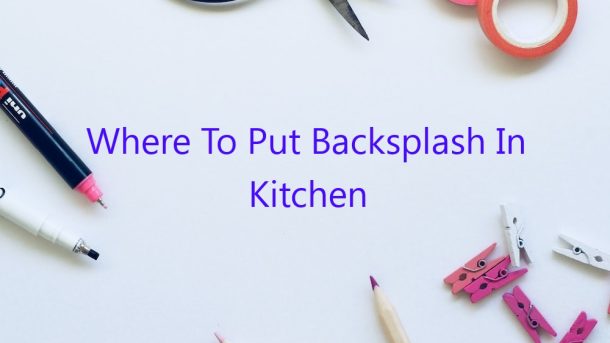When it comes to kitchens, there are a lot of decisions to make. What color should the cabinets be? What type of flooring should go down? One of the decisions that can really make or break a kitchen is the backsplash.
There are a lot of different materials that can be used for a backsplash, but one of the most popular is tile. Tile comes in a variety of colors, shapes, and sizes, so it can be used to match any style kitchen. There are also a lot of different ways to install tile, which means that it can be used in any type of kitchen.
Another popular material for a backsplash is marble. Marble is a luxurious material that can really elevate the look of a kitchen. It is also a very durable material, so it can stand up to a lot of wear and tear.
There are a lot of different places that a backsplash can be installed. Some people install it right above the countertops, while others install it all the way up to the ceiling. It really depends on the look that you are going for.
If you are looking for a sleek and modern look, you may want to install the backsplash right above the countertops. This will create a clean and polished look. If you are going for a more traditional look, you may want to install the backsplash all the way up to the ceiling. This will add a lot of character to your kitchen.
No matter where you decide to install the backsplash, it is sure to add a lot of style and personality to your kitchen.
Contents
Where should backsplash be placed in kitchen?
Backsplash is an important aspect of any kitchen design as it protects your walls from potential food and liquid splatters. But where exactly should this protective layer be placed?
There is no one-size-fits-all answer to this question, as the best location for your backsplash will vary depending on your kitchen’s layout and specific needs. However, there are a few general guidelines you can follow to help you choose the right spot.
If your kitchen has a lot of counter space, you may want to place your backsplash behind the countertops. This will help protect the walls from spills and splatters, and will also create a visual barrier between the countertops and the rest of the room.
If your kitchen has an open layout, or if you have a lot of cabinets and appliances on the walls, you may want to place your backsplash on the wall behind the cooking area. This will protect the walls from heat and cooking splatters, and will also help keep the kitchen clean.
If you have a tile or stone backsplash, you may want to place it at the bottom of the wall, near the countertops. This will help protect the backsplash from spills and splatters, and will also help keep the kitchen clean.
No matter where you decide to place your backsplash, be sure to consult with a professional kitchen designer to get expert advice on the best location for your specific kitchen.
Where should backsplash begin and end?
When it comes to kitchen design, backsplash is a key detail that can make or break the overall look. But one question often arises when it comes to this feature: where should backsplash begin and end?
There are no hard and fast rules when it comes to this, but there are a few things to keep in mind when making your decision. First, consider the width of your backsplash. It should be wide enough to cover the entire area behind your sink and stove, but not so wide that it overwhelms the rest of the kitchen.
Another thing to keep in mind is the materials you use for your backsplash. If you’re using tile, for example, make sure the edges of the tiles are sealed so that water and other liquids don’t seep behind them and cause damage to your walls.
As a general rule, it’s best to start your backsplash at the countertop and end it at the bottom of your cabinets. This will help to create a cohesive look in your kitchen.
If you’re still not sure where to start or end your backsplash, consult with a professional kitchen designer for some guidance. They will be able to help you create a backsplash that is both beautiful and functional.
Does backsplash go around the whole kitchen?
When it comes to kitchen design, one of the most important decisions you’ll make is whether or not to install a backsplash. This protective layer of tiles or other material helps to keep your walls clean and protect them from spills and splatters. But when it comes to the actual design of your backsplash, there’s a lot of flexibility. One question that often comes up is whether or not the backsplash should go all the way around the kitchen.
The answer to this question depends on a few factors. First, you’ll need to decide how much of your kitchen backsplash you want to see. Some people prefer to have a full backsplash that covers the entire wall behind the countertop, while others prefer a more minimalist look with just a small splash of color or pattern. If you’re going for a more minimal look, you may not want to extend the backsplash all the way around the kitchen.
Another factor to consider is the layout of your kitchen. If your kitchen is open to the rest of your house, you may want to consider extending the backsplash to the other side of the kitchen to help create a cohesive look. If your kitchen is closed off from the rest of your home, you may not need a backsplash on the other side.
Ultimately, the decision of whether or not to extend your backsplash all the way around your kitchen is up to you. There’s no right or wrong answer, and it all comes down to personal preference. So take some time to think about what you want, and then make the decision that’s best for you and your home.
Where should backsplash end cabinet or countertop?
A backsplash is a protective wall that is installed behind a kitchen sink and stove. It helps to protect the walls from food and water damage. Backsplashes are typically made from tile, stone, or metal.
When installing a backsplash, it is important to decide where it should end. Some people choose to extend the backsplash all the way to the ceiling, while others choose to stop it at the countertop or cabinet.
If you are installing a backsplash between your countertop and cabinets, there are a few things to consider. First, you need to decide if you want the backsplash to end at the same height as the countertop or cabinet. You also need to decide if you want the backsplash to be even with the countertop or cabinet, or if you want it to be slightly elevated.
If you choose to have the backsplash end at the same height as the countertop or cabinet, you will need to make sure that the backsplash is the same height on both sides. If you choose to have it be even with the countertop or cabinet, you will need to make sure that the backsplash is the same width on both sides.
If you want the backsplash to be elevated, you will need to decide how high you want it to be. Usually, it is recommended that the backsplash be at least two inches higher than the countertop or cabinet.
If you are using tile or stone for your backsplash, you will need to make sure that the countertop or cabinet is at least the same height as the tile or stone. If the countertop or cabinet is lower than the tile or stone, you will need to use a trim piece to finish the edge.
If you are using metal for your backsplash, you will need to make sure that the countertop or cabinet is at least one inch higher than the metal. If the countertop or cabinet is lower than the metal, you will need to use a trim piece to finish the edge.
Ultimately, the decision on where to end the backsplash is up to you. However, it is important to consider the height of the countertop or cabinet, and the material that you are using for the backsplash.
Do you put backsplash behind stove?
When remodeling a kitchen, one of the decisions you’ll need to make is whether to put a backsplash behind the stove. There are pros and cons to both options, so let’s take a look at them.
Putting a backsplash behind the stove has several benefits. First, it protects the wall from grease and splatters. Second, it can add visual interest to the kitchen. Third, it can help to protect the wall from heat damage.
However, there are also some drawbacks to putting a backsplash behind the stove. First, it can be difficult to clean. Second, it can add to the cost of the remodel. Third, it can limit your options for stove placement.
Ultimately, the decision of whether to put a backsplash behind the stove is up to you. If you think the benefits outweigh the drawbacks, then go for it! If not, then you may want to skip it.
Do you put backsplash on side walls?
Do you put backsplash on side walls? This is a question that many homeowners have when they are remodeling their kitchens. The answer to this question is it depends.
There are a few factors that you need to consider when deciding whether or not to put backsplash on side walls. The first factor is the type of material that you are using for your backsplash. If you are using a material that is not waterproof, such as tile, you will need to put backsplash on side walls.
Another factor to consider is the type of cabinets that you have. If you have cabinets that are made from a wood or other porous material, you will need to put backsplash on side walls. This is because water can seep through the cabinets and damage the wall behind them.
If you are unsure whether or not you should put backsplash on side walls, it is best to consult with a professional. They will be able to advise you on the best course of action for your specific situation.
Does backsplash sit on countertop?
When it comes to kitchen design, one of the most important decisions you’ll make is what to do about your backsplash. This area of the kitchen wall can be covered in a variety of materials, from tile to metal to plastic, and each has its own benefits and drawbacks.
One question that often arises during this process is whether the backsplash should sit on top of the countertop or be attached to the wall behind it. Let’s take a look at the pros and cons of each option.
Attaching the Backsplash to the Wall
The biggest benefit of attaching the backsplash to the wall is that it creates a clean, seamless look. There are no gaps between the countertop and the backsplash, which can make the kitchen look more polished and put-together.
Another advantage of this option is that it can help protect the wall behind the countertop from water and grease damage. This is particularly important if your kitchen has an open floor plan and the countertops run all the way to the wall.
The main downside of attaching the backsplash to the wall is that it can be difficult and expensive to install. You’ll need to have a professional install it, and it may require some drilling and cutting to get the perfect fit.
Attaching the Backsplash to the Countertop
The biggest benefit of attaching the backsplash to the countertop is that it is relatively easy and inexpensive to do. You can usually do it yourself, and there are no special tools or skills required.
Another advantage of this option is that it provides more flexibility when it comes to choosing your backsplash material. If you change your mind about the material or color later on, it’s easy to switch it up.
The main downside of attaching the backsplash to the countertop is that it can create a visual break between the countertop and the wall. This can make the kitchen look less polished and put-together.
So, which option is right for you?
If you’re looking for a sleek, polished look, attaching the backsplash to the wall is the way to go. If you’re looking for more flexibility and affordability, attaching it to the countertop is the better option.




